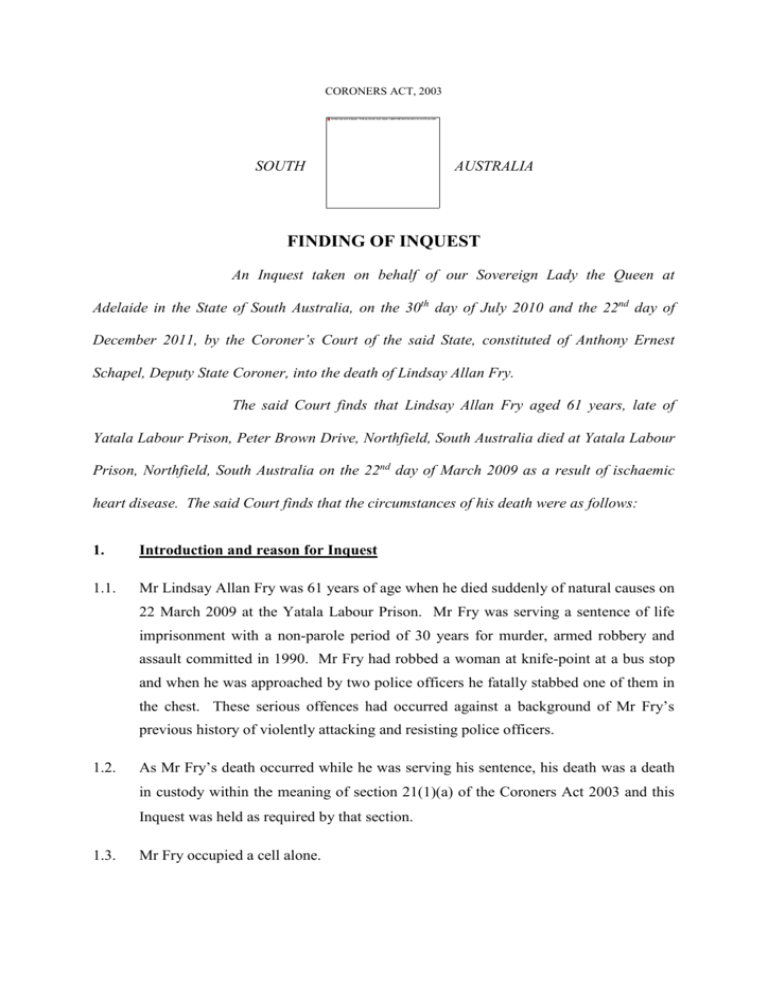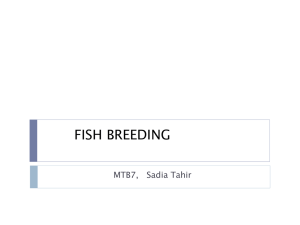FRY Lindsay Allan - Courts Administration Authority
advertisement

CORONERS ACT, 2003 SOUTH AUSTRALIA FINDING OF INQUEST An Inquest taken on behalf of our Sovereign Lady the Queen at Adelaide in the State of South Australia, on the 30th day of July 2010 and the 22nd day of December 2011, by the Coroner’s Court of the said State, constituted of Anthony Ernest Schapel, Deputy State Coroner, into the death of Lindsay Allan Fry. The said Court finds that Lindsay Allan Fry aged 61 years, late of Yatala Labour Prison, Peter Brown Drive, Northfield, South Australia died at Yatala Labour Prison, Northfield, South Australia on the 22nd day of March 2009 as a result of ischaemic heart disease. The said Court finds that the circumstances of his death were as follows: 1. Introduction and reason for Inquest 1.1. Mr Lindsay Allan Fry was 61 years of age when he died suddenly of natural causes on 22 March 2009 at the Yatala Labour Prison. Mr Fry was serving a sentence of life imprisonment with a non-parole period of 30 years for murder, armed robbery and assault committed in 1990. Mr Fry had robbed a woman at knife-point at a bus stop and when he was approached by two police officers he fatally stabbed one of them in the chest. These serious offences had occurred against a background of Mr Fry’s previous history of violently attacking and resisting police officers. 1.2. As Mr Fry’s death occurred while he was serving his sentence, his death was a death in custody within the meaning of section 21(1)(a) of the Coroners Act 2003 and this Inquest was held as required by that section. 1.3. Mr Fry occupied a cell alone. 2 1.4. On the day of Mr Fry’s death, 22 March 2009, he was visited in his cell at 7:45am by a Registered Nurse, Carmel Pezzanite1, who handed him his medication and watched him apparently take it. Ms Pezzanite gave Mr Fry his Metformin, Gliclazide and Aspirin. At 10:15am Mr Fry attended upon the Infirmary and saw Ms Pezzanite who assisted him with his shower and dressed a wound on his foot. Additionally, Ms Pezzanite cut Mr Fry’s fingernails. She stated that Mr Fry was in a good mood and was very talkative. She stated that she told him to wash his hands and comb his hair at which he laughed. 1.5. Mr Fry was locked in his cell in J Wing, Unit 2, E Division at about 11:25am for lunch. A custodial officer, Julie McDowell2, saw Mr Fry and asked him to collect the orange which was sitting on his trap window so that it could be closed. Mr Fry got up, collected the orange and sat back down again. Ms McDowell detected nothing about Mr Fry that concerned her at that time. 1.6. At 1:10pm the cells were unlocked. As custodial officer, Susan Presley, opened Mr Fry’s cell and saw that Mr Fry was ‘lying on the ground with his walking frame underneath him’3. A code black was called by Ms McDowell. RN Pezzanite and another registered nurse arrived in response at 1:12pm. Mr Fry was observed by RN Pezzanite to be lying on his side. He was unconscious, very pale and was unresponsive. He was not breathing and a pulse could not be detected. Attempts at defibrillation revealed that Mr Fry was unshockable. His pupils were fixed which signified that Mr Fry was already deceased. Nevertheless oxygen was administered and CPR was commenced. SAAS attended. They found no pulse and Mr Fry was unresponsive. He was quite clearly deceased upon SAAS arrival. Nevertheless they and continued CPR and made other attempts at resuscitation including an attempt to gain IV access. Despite their efforts Mr Fry was declared life extinct at 1:39pm on 22 March 2009. 1.7. I am satisfied that there was no indication given to corrections staff nor to prison health staff that Mr Fry would imminently collapse such that a greater level of scrutiny of him that day might have been required. I am satisfied that everything that could be done by way of attempted resuscitation was done. It is more probable that 1 Exhibit C8a Exhibit C7b 3 Exhibit C6a 2 3 not that Mr Fry was already deceased before the registered nurses entered his cell in response to the code black. 2. Cause of death 2.1. Following Mr Fry’s death, a post-mortem examination was conducted by Professor Roger Byard, a senior specialist forensic pathologist at Forensic Science South Australia (FSSA). In his post-mortem report dated 12 June 20094, Professor Byard expresses the opinion that the cause of death was ‘ischaemic heart disease’. The anatomical findings included marked coronary artery atherosclerosis with myocardial and endocardial fibrosis, moderate cardiomegaly, which is enlargement of the heart, an old infarct in the right basal ganglia of the brain, cerebrovascular atheroma and the surgical absence of the right big and index toes. Professor Byard stated: 'Death was due to ischaemic heart disease with significant atherosclerotic narrowing of all three major epicardial coronary arteries associated with fibrous scarring of the heart. Although no acute ischaemic changes were observed microscopically, these take a number of hours to develop before they can be seen histologically. In addition, lethal arrhythmias may occur in the absence of overt infarction. A compounding factor may have been the presence of moderate cardiomegaly. There was also evidence of atherosclerotic vascular disease elsewhere with a previous infarct in the brain. There is no evidence of significant trauma. Toxicological analyses revealed no alcohol or common drugs in the blood.'5 2.2. In an addendum report that Professor Byard compiled in order to address certain concerns raised by Mr Fry’s family, he further explains Mr Fry’s cause of death: '1. Cause of death Mr Lindsay died of ischaemic heart disease. This refers to a form of heart attack when the heart is not receiving enough oxygen to function properly. An irregular heartbeat occurs, often followed by rapid death. There were a number of causes of a significant reduction in the supply of oxygen to the heart in this case including: i) marked narrowing of all three major coronary arteries ii) narrowing of the opening of the left coronary artery iii) enlargement of the heart iv) scarring of the heart 4 5 Exhibit C3a Exhibit C3a, page 2 4 There was also evidence of previous heart attacks with scarring of the heart and of vascular problems elsewhere with a previous stroke. When people die quickly from heart attacks there are usually no acute changes that can be seen under the microscope.' 6 2.3. There were other findings from the autopsy that I should mention. In his original report Professor Byard describes a bleeding intravenous puncture wound with bruising that was present in the right cubital fossa (right elbow) and a similar puncture wound that was present in the left cubital fossa (left elbow). There is nothing sinister about these puncture wounds. Professor Byard describes these findings as evidence of medical intervention. In his addendum report Professor Byard states that these wounds were consistent with injection marks typical of those sustained during attempted resuscitation. 2.4. I have mentioned Professor Byard’s autopsy findings in some detail as Mr Fry’s family have raised certain concerns in relation to the cause and manner of Mr Fry’s death. I will briefly mention some of these concerns later in these findings, but they are unfounded and unsupported by evidence. As will be seen, Mr Fry suffered from diabetes that was poorly controlled, essentially as a result of a lack of self care and an unwillingness to accept medical advice and intervention. His cause of death of ischaemic heart disease is quite in keeping with that history. The condition of Mr Fry’s toes was but one clinical manifestation of poorly controlled diabetes during his lifetime. 2.5. The evidence that Mr Fry died of an acute episode of ischaemic heart disease is overwhelming. I find ischaemic heart disease to have been the cause of Mr Fry’s death. 3. Background and previous medical history 3.1. Mr Fry was held at various custodial institutions over the 19 years he was in prison. At the time of his death he was housed at Yatala Labour Prison as it had 24-hour medical care. 3.2. When Mr Fry was originally sentenced for the offences that led to his incarceration, the sentencing judge referred to the assessment as made by psychiatrists that Mr Fry’s intellectual level was little above that of the intellectually retarded range. There are further references to Mr Fry’s intellectual deficits in his prison case notes. 6 Exhibit C3b 5 3.3. Mr Fry suffered from poor physical health for many years. He had received ongoing medical treatment for his chronic illnesses over the years, including diabetes and high cholesterol. In the early 1990s Mr Fry suffered from recurring bouts of cellulitis, or swelling, in his legs. Investigations were undertaken as to the cause of this recurring problem and it was found that Mr Fry suffered from Adult Onset Type II Diabetes. As treatment for his diabetes, he was prescribed medications. At the time of his death Mr Fry was prescribed Metformin 850mg, Gliclazide 80mg and 100mgs of Aspirin. In addition, attempts were made to alter Mr Fry’s diet. 3.4. As early as 1996, while in Port Augusta Prison, Mr Fry was ordered onto a diabetic diet by the Prison Health Service. Mr Fry continually refused to eat the diabetic food offered to him and appeared uncaring about the ramifications. An example of this is reflected in the Prison Health Service notes on 20 September 1996, where the Registered Nurse records her conversation with Mr Fry. She wrote: 'In regards to Lindsay’s diet when I said to Lindsay “You are a diabetic, you are on a diabetic diet” he just laughed. Note that CNC Plumb has contacted a dietician.' 7 Prison Health Service staff continually but largely unsuccessfully attempted to persuade Mr Fry to better manage his diabetes. The Prison Health Service then brought in a dietician in to see him in 1996. Following that they contacted the State Ombudsman to see if Mr Fry could be banned from certain foods or drinks, but were told that this was not possible. They were told to keep trying to discuss the matter with Mr Fry and keep contact with a medical officer. Diabetic meals, created with the input of the Royal Adelaide Hospital (RAH) dieticians, were available to Mr Fry until the time of his death. 3.5. Mr Fry was prescribed diabetes medication of Metformin, Gliclazide and Aspirin. Mr Fry had been a long term problem patient in complying with his medical regime. He refused to take his prescribed medications, to undertake basic medical screenings and to attend upon the medical staff. There are numerous references scattered throughout the volumes of the Prison Health Service notes8 where staff have recorded each time they have tried to encourage Mr Fry to have his blood glucose levels monitored, or to take his medications. In 2000 a psychological evaluation of Mr Fry was undertaken to assess his capacity to make his own medical decisions. He was found to be have a 7 8 Exhibit C29 Exhibit C29 6 borderline intellectual disability but was found to be aware of the relationship between causal symptoms of diabetes and the effect of medication, of the risks of not completing treatment and of the impact untreated diabetes had on other his other medical conditions9. 3.6. As a result of Mr Fry’s non compliance with any form of regulation of his diabetes, he suffered medical difficulties. In March 1999 Mr Fry was sent to the RAH’s Endocrine Outpatient Service in order to assess his swollen and painful left leg. Dr Clifton, who attended upon Mr Fry, stated in his report10 that Mrs Fry’s blood sugar levels (BSL) were between 14.8 and 22, and that he did not doubt that Mr Fry’s untreated diabetes was the significant reason for the constant exacerbations to his left leg cellulitis. Dr Clifton did not believe this would improve until Mr Fry’s BSLs improved. Mr Fry was adamant that he was not going to take any medication or consider dieting and he was returned to prison with Dr Clifton saying there was little he could do as long as Mr Fry refused treatment. 3.7. In September 2001 Mr Fry was admitted to the RAH with uncontrollable movements in his left leg and arm. These movements were so bad that he was unable to walk. Mr Fry was diagnosed with having had a stroke and on provision of medication the symptoms dissipated. He was returned to prison. 3.8. That Mr Fry had a somewhat cavalier attitude towards his own health is exemplified by a statement that is recorded in his Prison Health Service progress notes where on 14 April 2008 he indicated that although he was not suicidal, he was not concerned by complications of untreated diabetes11. It is also evident that in spite of the fact that Mr Fry was provided with and was encouraged to consume diabetic meals, he habitually purchased and consumed sweets and sugary drinks. 3.9. On 2 June 2008 Mr Fry had a seizure and was initially admitted to the Murray Bridge Hospital but, due to his precarious presentation, he was retrieved to the RAH. Mr Fry was found to be hyperglycaemic with a BSL of 24.7. Urgent medical attention brought his BSL back down to 5.4. Once able, Mr Fry refused all further medication and was released back to prison. On 20 September 2008 Mr Fry suffered from a second stroke and was again admitted to the RAH. On admission to hospital Mr Fry 9 Exhibit C21h, page 3 Exhibit C28 11 Exhibit C21h 10 7 was noted to refuse all diabetic medication. Dr David King12, who reviewed Mr Fry at the RAH, stated that complications of Type II diabetes relate to arterial disease can include peripheral vascular disease leading to gangrene and amputation, which is what Mr Fry was treated for. Dr King stated that patients with this kind of disease can suffer coronary disease which may result in heart attacks and cerebra-vascular disease, which can lead to stroke. Mr Fry continued to be non-compliant with his medication and over the years suffered from ongoing infections in his feet and swelling in his limbs. On 1 December 2008 Mr Fry was admitted to the RAH with an infection in his right foot. This was found to be gangrenous and he had two toes amputated from that foot. Following surgery Mr Fry was seen by the Prison Health Service every day for wound management. 3.10. According to Dr Richard Frost who is the Clinical Director of the South Australian Prison Health Service13, medical staff saw Mr Fry on a daily basis at Yatala Prison. His last BSL was taken on 21 March 2009, the day before he died. It was on this occasion 11.2 which, although high, was not considered high having regard to Mr Fry’s usual levels. 3.11. RN Pezzanite who had worked at Yatala for a period of about 18 months up to the time of Mr fry’s death confirms that Mr Fry had been problematic with compliance with medical treatment and had sometimes been hostile in relation to his health care. She does say, however, that he seemed to have mellowed over the previous 12 months. She also states that Mr Fry had improved in the taking of this medication in the month prior to the day of his death14. 3.12. I have not identified any deficiency in Mr Fry’s health care while in custody. 4. Toxicological analysis 4.1. A toxicology screen was undertaken by Heather Felgate, forensic scientist at FSSA15. This report revealed that there was no alcohol or licit or illicit drugs found in Mr Fry’s blood. The toxicological analysis, as a general screen, tested for the medication Gliclazide that had been provided to Mr Fry by RN Pezzanite that morning. The screen came back clear, indicating that no Gliclazide was found in Mr Fry’s blood. 12 Exhibit C12a Exhibit C11a 14 Exhibit C8a 15 Exhibit C4a 13 8 An additional toxicology report was performed by Kerryn Mason, forensic scientist at FSSA, in order to specifically screen for the drug Metformin16. This screen came back clear, indicating that there was also no Metformin in Mr Fry’s blood. These two toxicology reports reveal that, although Mr Fry was observed to take his medication, he was not ingesting them. I observe that it is recorded in Mr Fry’s Offender case notes that at least in the year 2000 Mr Fry had been in the habit of taking medication from the medics and then spitting it out after he returned to the cell and that this behaviour was described as an ongoing issue17. 5. Concerns raised by Mr Fry’s family 5.1. Mr Fry’s family have raised the issue of why his insulin level was not tested upon his death. Professor Byard specifically looked at this question in his additional report18 and he stated that he did not test for insulin as there was no suggestion that Mr Fry was being injected with it and that no syringe was found at the scene. Mr Fry was not taking insulin as he was not a Type I diabetic and as such did not require insulin. 5.2. As seen, Professor Byard stated that the puncture sites in Mr Fry’s arms can be explained by attempts at IV cannulation by the South Australian Ambulance Service (SAAS) as part of their efforts at resuscitation19. 5.3. In addition, the family have raised concerns about two bruises found on Mr Fry which are detailed in Professor Byard’s original report20. These are described as a linear abrasion measuring 70x80mm on the right side of the chest and one was 30x20mm on the right upper arm. These bruises are not inconsistent with having been sustained as part of Mr Fry’s fall when he collapsed on top of his walking frame. 5.4. There are a number of other matters raised in the letter of Mr Graham Fry and Ms Marilyn Yates, the children of Mr Fry, concerning the origin of a previous stroke and the authorities’ awareness of the same. The letter also raises questions that have evidently been posed by a medical practitioner who has had access to Professor Byard’s post-mortem report. None of these matters raise any serious issue as to the cause and circumstances of Mr Fry’s death. Certainly, the matters apparently raised 16 Exhibit C23 Exhibit C21i, page 87 See also the letter of David Curnow, Senior Psychologist, Port Augusta Prison dated 29 September 2000 at page 1 18 Exhibit C3b 19 Exhibit C2b - SAAS Patient Report Form - IV Cannulation marked as unsuccessful 20 Exhibit C3a 17 9 by the medical practitioner cannot and do not raise any question as to the accuracy of Professor Byard’s stated cause of death. In particular, in Professor Byard’s addendum report he refutes the suggestion of an insulin overdose as having been responsible for Mr Fry’s death. I would in any event and for obvious reasons prefer the analysis of an experienced forensic pathologist who has conducted an autopsy to that of a general practitioner who has not. 5.5. There is nothing suspicious about the circumstances of Mr Fry’s death. 6. Recommendations 6.1. I have no recommendations to make in this matter. Key Words: Death in Custody; Natural Causes In witness whereof the said Coroner has hereunto set and subscribed his hand and Seal the 22nd day of December, 2011. Deputy State Coroner Inquest Number 23/2010 (0508/2009)






